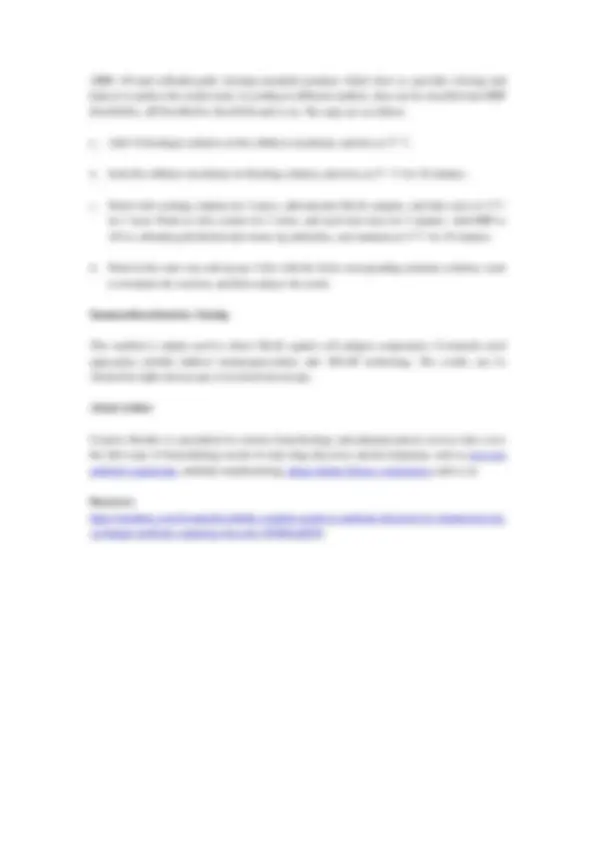



Study with the several resources on Docsity

Earn points by helping other students or get them with a premium plan


Prepare for your exams
Study with the several resources on Docsity

Earn points to download
Earn points by helping other students or get them with a premium plan
Community
Ask the community for help and clear up your study doubts
Discover the best universities in your country according to Docsity users
Free resources
Download our free guides on studying techniques, anxiety management strategies, and thesis advice from Docsity tutors
The immunoenzyme technique is an immunological technique that combines the specificity of the antigen-antibody reaction and the efficient catalytic action of the enzyme on the substrate's color reaction. Because of its specificity and high sensitivity, it has been widely used for screening and identification of monoclonal antibody.
Typology: Study Guides, Projects, Research
1 / 2

This page cannot be seen from the preview
Don't miss anything!


The Complete Guide to Antibody Detection by Immunoenzyme Technique: Antibody Capturing ELISA, ABC-ELISA, Dot-ELISA and Immunohistochemistry Stainig The immunoenzyme technique is an immunological technique that combines the specificity of the antigen-antibody reaction and the efficient catalytic action of the enzyme on the substrate's color reaction. Because of its specificity and high sensitivity, it has been widely used for screening and identification of monoclonal antibody. Antibody Capturing ELISA a. Coat the enzyme plate with purified anti-mouse Ig antibodies of appropriate concentration. Add 100ul into each hole, and maintain at 37℃ for 2 hours or at 4℃ overnight. b. After washing and patting dry the plate from the last step, add McAb samples remained untested. Maintain it at 37℃ for 1-2 hours. c. After washing the plate from the last step, add appropriate amount of antigens, and maintain it at 37 ℃ for 1-2 hours. d. Wash the plate from the last step, add the enzyme-labeled polyclonal antibodies, and maintain at 37 ℃ for 1-2 hours. After washing, add the substrate to show color. Analyze the result according to the color. ABC-ELISA ABC-ELISA is based on the conventional ELISA principle. It increases the amplification function between biotin and avidin. Avidin consisting of four subunits has high affinity to biotin. Biotin is easy to covalently bind to protein. Thus, avidin binding with enzymes reacting to biotin binding with antibodies can lead to multipolar amplification. The steps are as follows. a. Coat the known antigens and add untested McAb samples, which is the same as indirect ELISA. b. Add 100ul biotinylated anti-mouse Ig antibodies to each hole. Maintain at 7 ℃ for 1 hour and then wash. c. Add 100ul enzyme-labeled avidin into each hole. Wash at 37℃ for 30 minutes. Add the substrate to show color, and analyze the result according to the color. Dot-ELISA Dot-ELISA is an immune detection means which uses nitrocellulose membrane or cellulose acetate membrane as a solid carrier to lead antigen-antibody reaction. This method uses insoluble substrates (such as DAB, 4-chloronaphthol or AgNO3, etc.) to react with corresponding markers
(HRP, AP and colloidal gold), forming insoluble products which show as spot-like coloring and help us to analyze the result easily. According to different markers, they can be classified into HRP Dot-ELISA, AP Dot-ELISA, Dot-IGSS and so on. The steps are as follows. a. Add 2-5ul antigen solution on the cellulose membrane, and dry at 37 ℃. b. Soak the cellulose membrane in blocking solution, and store at 37 ° C for 30 minutes. c. Wash with washing solution for 2 times, add untested McAb samples, and then store at 37℃ for 1 hour. Wash in vibro washer for 3 times, and each time lasts for 5 minutes. Add HRP or AP or colloidal gold labeled anti-mouse Ig antibodies, and maintain at 37℃ for 30 minutes. d. Wash in the same way and sip up. Color with the fresh corresponding substrate solution, wash to terminate the reaction, and then analyze the result. Immunohistochemistry Stainig This method is mainly used to detect McAb against cell antigen components. Commonly used approaches include indirect immunoperoxidase and APAAP technology. The results can be checked by light microscope or inverted microscope. About Author Creative Biolabs is specialized in custom biotechnology and pharmaceutical services that cover the full scope of biotechnology needs of early drug discovery and development, such as next gen antibody sequencing, antibody manufacturing, phage display library construction, and so on. Resource: https://medium.com/@candyjkswift/the-complete-guide-to-antibody-detection-by-immunoenzyme